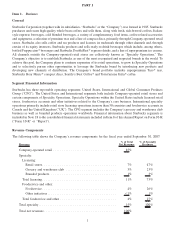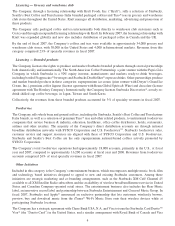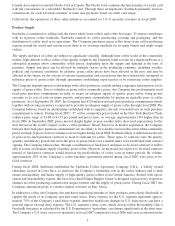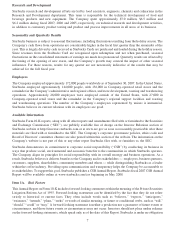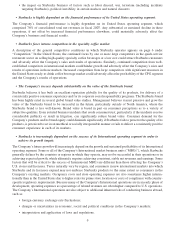Starbucks 2007 Annual Report Download - page 13
Download and view the complete annual report
Please find page 13 of the 2007 Starbucks annual report below. You can navigate through the pages in the report by either clicking on the pages listed below, or by using the keyword search tool below to find specific information within the annual report.•Effectively managing the Company’s rapid growth is challenging.
The Company’s long-term goal is to open approximately 20,000 Starbucks stores in the United States and at least
20,000 stores in International markets. Starbucks expects to double the size of its business over the next four to five
years and achieve higher annual growth in net earnings than revenue. Effectively managing growth on this scale is
challenging, particularly as Starbucks expands into new markets internationally, where it must balance the need for
flexibility and a degree of autonomy for local management with consistency with the Company’s goals, philosophy
and standards. Growth on this scale makes it increasingly difficult to ensure a consistent supply of high quality raw
materials, to locate and hire sufficient numbers of key employees to meet the Company’s growth targets, to maintain
an effective system of internal controls for a globally dispersed enterprise and to train employees worldwide to
deliver a consistently high quality product and customer experience.
•The loss of key personnel or difficulties recruiting and retaining qualified personnel could jeopardize
the Company’s ability to meet its growth targets.
The Company’s future growth depends substantially on the contributions and abilities of key executives and other
employees. Starbucks future growth also depends substantially on its ability to recruit and retain high quality
employees to work in and manage Starbucks stores. Starbucks must continue to recruit, retain and motivate
management and other employees sufficient to maintain its current business and support its projected growth. A loss
of key employees or a significant shortage of high quality store employees could jeopardize the Company’s ability
to meet its growth targets.
•Adverse public or medical opinions about the health effects of consuming the Company’s products, as
well as reports of incidents involving food-borne illnesses or food tampering, whether or not accurate,
could harm its business.
Some Starbucks products contain caffeine, dairy products, sugar and other active compounds, the health effects of
which are the subject of increasing public scrutiny, including the suggestion that excessive consumption of caffeine,
dairy products, sugar and other active compounds can lead to a variety of adverse health effects. There has also been
greater public awareness that sedentary lifestyles, combined with excessive consumption of high-calorie foods,
have led to a rapidly rising rate of obesity. Particularly in the United States, there is increasing consumer awareness
of health risks, including obesity, due in part to increasing publicity and attention from health organizations, as well
as increased consumer litigation based on alleged adverse health impacts of consumption of various food products.
While Starbucks has a variety of beverage and food items that are low in caffeine and calories, an unfavorable report
on the health effects of caffeine or other compounds present in the Company’s products, or negative publicity or
litigation arising from other health risks such as obesity, could significantly reduce the demand for the Company’s
beverages and food products.
Similarly, reports, whether true or not, of unclean water supply, food-borne illnesses and food tampering have in the
past severely injured the reputations of companies in the food processing, grocery and quick-service restaurant
sectors and could in the future affect the Company as well. Any report linking Starbucks to the use of unclean water,
food-borne illnesses or food tampering could damage its brand value, immediately and severely hurt sales of its
beverages and food products, and possibly lead to product liability claims. Clean water is critical to the preparation
of specialty coffee beverages. The Company’s ability to ensure a clean water supply to its stores is limited,
particularly in some International locations. If customers become ill from food-borne illnesses, the Company could
also be forced to temporarily close some stores. In addition, instances of food-borne illnesses or food tampering,
even those occurring solely at the restaurants or stores of competitors, could, by resulting in negative publicity about
the foodservice industry, adversely affect Starbucks sales on a regional or global basis. A decrease in customer
traffic as a result of these health concerns or negative publicity, or as a result of a temporary closure of any of the
Company’s stores, could materially harm the Company’s business and results of operations.
11


